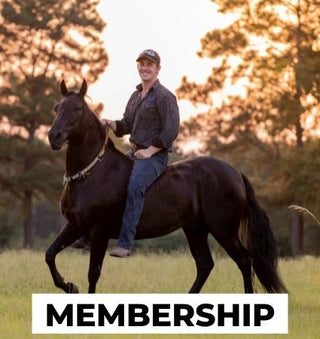Watch the Video Here or continue reading below!
When riding downhill, keeping your horse controlled and balanced is essential for both safety and comfort. If your horse rushes downhill, it can be a sign of fundamental training issues that need to be addressed. In this guide, we will discuss how to slow down on hills and develop a respectful, responsive horse.
Understanding the Problem: Why Horses Rush Downhill
Some horses have a tendency to speed up when descending hills, becoming heavy on the forehand. This often happens because they are not properly trained to balance themselves and respect rein pressure. A horse that grabs the bit and charges downhill is not only uncomfortable to ride but also at risk of injury.
One example is PJ, a horse that initially rushed down hills, making it difficult to control his speed. With proper training and respect exercises, he learned to descend carefully with a light rein and controlled movement.
Fundamentals First: Respect and Softness
Many advanced riding problems stem from fundamental training gaps. If your horse is difficult to control downhill, you should revisit basic respect training. Here’s what your horse should be able to do before tackling hills:
-
Give to pressure – The horse should respond softly to rein cues, giving its head left, right, and in the center.
-
Back up easily – Your horse should back up without resistance, even on an incline.
-
Move while remaining soft – The horse should flex and move fluidly, maintaining lightness on the reins.
By reinforcing these basic skills, you will create a more responsive and safe horse for downhill riding.
Practical Exercises to Improve Control
If your horse struggles with hills, go back to groundwork and saddle work exercises. Here are some essential steps:
1. Groundwork for Respect
-
Teach your horse to back up willingly without pressure.
-
Ensure they give their head easily in both directions.
2. Flexion and Softness Under Saddle
-
Practice flexing left and right while standing and in motion.
-
Encourage softness in the bridle by keeping rein pressure light, similar to turning a car’s steering wheel.
3. Controlled Descents
-
Start with small inclines, using rein cues to maintain a slow pace.
-
If the horse begins to rush, ask for a stop or a slight back-up to reset balance.
Maintaining a Relaxed and Balanced Ride
Once your horse is responsive to rein pressure and moves softly, downhill riding becomes much easier. When done correctly, you can enjoy a calm, controlled descent—even holding a drink in one hand while guiding your horse with the other!
By taking the time to build respect and responsiveness, you’ll have a horse that listens and moves with care, ensuring a safe and enjoyable ride on any terrain.









